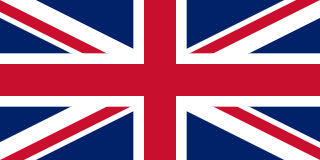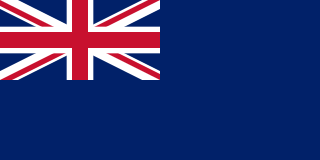Related Research Articles

The Union Jack, or Union Flag, is the de facto national flag of the United Kingdom. Although no law has been passed making the Union Flag the official national flag of the United Kingdom, it has effectively become such through precedent. It is sometimes asserted that the term Union Jack properly refers only to naval usage, but this assertion was dismissed by the Flag Institute in 2013 following historical investigations. The flag has official status in Canada, by parliamentary resolution, where it is known as the Royal Union Flag. It is the national flag of all British overseas territories, being localities within the British state, or realm, although local flags have also been authorised for most, usually comprising the blue or red ensign with the Union Flag in the canton and defaced with the distinguishing arms of the territory. These may be flown in place of, or along with the national flag. Governors of British Overseas Territories have their own personal flags, which are the Union Flag with the distinguishing arms of the colony at the centre. The Union Flag also appears in the canton of the flags of several nations and territories that are former British possessions or dominions, as well as in the flag of the US State of Hawaii, which has no such connection.

The flag of England is the national flag of England, a constituent country of the United Kingdom. It is derived from Saint George's Cross. The association of the red cross as an emblem of England can be traced back to the Late Middle Ages when it was gradually, increasingly, used alongside the Royal Banner. It became the only saint's flag permitted to be flown in public as part of the English Reformation and at a similar time became the pre-eminent maritime flag referred to as a white ensign. It was used as a component in the design of the Union Jack in 1606.

The flag of Scotland is the national flag of Scotland, which consists of a white saltire defacing a blue field. The Saltire, rather than the Royal Standard of Scotland, is the correct flag for all private individuals and corporate bodies to fly. It is also, where possible, flown from Scottish Government buildings every day from 8:00 am until sunset, with certain exceptions.

The Red Ensign or "Red Duster" is the civil ensign of the United Kingdom of Great Britain and Northern Ireland. It is one of the British ensigns, and it is used either plain or defaced with a badge or other emblem, mostly in the right half.

In heraldry, Saint George's Cross, the Cross of Saint George, is a red cross on a white background, which from the Late Middle Ages became associated with Saint George, the military saint, often depicted as a crusader.

The royal coat of arms of the United Kingdom, or the royal arms for short, is the arms of dominion of the British monarch, currently King Charles III. These arms are used by the King in his official capacity as monarch of the United Kingdom. Variants of the royal arms are used by other members of the British royal family, by the Government of the United Kingdom in connection with the administration and government of the country, and some courts and legislatures in a number of Commonwealth realms. A Scottish version of the royal arms is used in and for Scotland. The arms in banner form serve as basis for the monarch's official flag, the Royal Standard.

The national flag of the United Kingdom is the Union Jack, also known as the Union Flag.

The royal arms of England are the arms first adopted in a fixed form at the start of the age of heraldry as personal arms by the Plantagenet kings who ruled England from 1154. In the popular mind they have come to symbolise the nation of England, although according to heraldic usage nations do not bear arms, only persons and corporations do. The blazon of the arms of Plantagenet is: Gules, three lions passant guardant in pale or armed and langued azure, signifying three identical gold lions with blue tongues and claws, walking past but facing the observer, arranged in a column on a red background. Although the tincture azure of tongue and claws is not cited in many blazons, they are historically a distinguishing feature of the arms of England. This coat, designed in the High Middle Ages, has been variously combined with those of the Kings of France, Scotland, a symbol of Ireland, the House of Nassau and the Kingdom of Hanover, according to dynastic and other political changes occurring in England, but has not altered since it took a fixed form in the reign of Richard I of England (1189–1199), the second Plantagenet king.

The Blue Ensign is a flag, one of several British ensigns, used by certain organisations or territories associated or formerly associated with the United Kingdom. It is used either plain or defaced with a badge or other emblem.

The flag of the state of Rhode Island is white and consists of a gold anchor in the center surrounded by thirteen gold stars. A blue ribbon below the anchor bears the state's motto in gold: "HOPE". The flag is frequently depicted with golden fringe around the edges of the flag, although the fringe is never actually on the flag unless it is used in federal-level displays, much like the national flag.

The Union of the Crowns was the accession of James VI of Scotland to the throne of the Kingdom of England as James I and the practical unification of some functions of the two separate realms under a single individual on 24 March 1603. Whilst a misnomer, therefore, what is popularly known as "The Union of the Crowns" followed the death of James's cousin, Elizabeth I of England, the last monarch of the Tudor dynasty.

The flag of Great Britain, commonly known as King's Colours, the first Union Flag, the Union Jack, or the British flag, was used at sea from 1606 and more generally from 1707 to 1801. It was the first flag of Great Britain. It is the precursor to the Union Jack of 1801.

The Royal Banner of the Royal Arms of Scotland, also known as the Royal Banner of Scotland, or more commonly the Lion Rampant of Scotland, and historically as the Royal Standard of Scotland, or Banner of the King of Scots, is the royal banner of Scotland, and historically, the royal standard of the Kingdom of Scotland. Used historically by the Scottish monarchs, the banner differs from Scotland's national flag, the Saltire, in that its correct use is restricted by an Act of the Parliament of Scotland to only a few Great Officers of State who officially represent the Monarchy in Scotland. It is also used in an official capacity at royal residences in Scotland when the Head of State is not present.

North Britain is a term which has been occasionally used, particularly in the 17th and 18th centuries, for either the northern part of Great Britain or Scotland, which occupies the northernmost third of the island. "North Britains" could also refer to Britons from Scotland; with North Briton later the standard spelling. Its counterparts were South Britain, generally used to refer to England and Wales and West Britain, usually referring to Ireland.

Saint Patrick's Saltire or Saint Patrick's Cross is a red saltire on a white field. In heraldic language, it may be blazoned "argent, a saltire gules". The Saint Patrick's Flag is a flag composed of Saint Patrick's Saltire. The origin of the saltire is disputed. Its association with Saint Patrick dates from the 1780s, when the Anglo-Irish Order of Saint Patrick adopted it as an emblem. This was a British chivalric order established in 1783 by George III. It has been suggested that it derives from the arms of the powerful Geraldine or FitzGerald dynasty. Most Irish nationalists and others reject its use to represent Ireland as a "British invention" "for a people who had never used it".

Great Britain is an island in the North Atlantic Ocean off the north-west coast of continental Europe. With an area of 209,331 km2 (80,823 sq mi), it is the largest of the British Isles, the largest European island and the ninth-largest island in the world. It is dominated by a maritime climate with narrow temperature differences between seasons. The 60% smaller island of Ireland is to the west—these islands, along with over 1,000 smaller surrounding islands and named substantial rocks, form the British Isles archipelago.

The Piracy Act 1850, sometimes called the Pirates Repeal Act, is an Act of the Parliament of the United Kingdom. It relates to proceedings for the condemnation of ships and other things taken from pirates and creates an offence of perjury in such proceedings.

The Colony of New Zealand was a Crown colony of the United Kingdom of Great Britain and Ireland that encompassed the islands of New Zealand from 1841 to 1907. The power of the British government was vested in the Governor of New Zealand, as the representative of their monarch. The colony had three capitals: Old Russell in 1841; Auckland from 1841 to 1865; and Wellington, which was the capital until the colony's reorganisation into a Dominion, and continues to be the capital of New Zealand till the present day.

The Proclamation of Dungannon was a document produced by Sir Phelim O'Neill on 24 October 1641 in the Irish town of Dungannon. O'Neill was one of the leaders of the Irish Rebellion which had been launched the previous day. O'Neill's Proclamation set out a justification of the uprising. He claimed to have been given a commission signed and sealed on 1 October by the King of Ireland Charles I that commanded him to lead Irish Catholics in defence of the Kingdom of Ireland against Protestants who sympathised with Charles' opponents in the Parliament of England.
References
- ↑ "South Britain, or England and Wales. / Bowen, Emanuel / 1747". Davidrumsey.com. 22 February 1999. Retrieved 18 December 2011.
- ↑ Jones, Charles (1997). The Edinburgh history of the Scots ... - Charles Jones - Google Books. ISBN 9780748607549 . Retrieved 18 December 2011.
- ↑ Griffin, Dustin (17 November 2005). Patriotism and Poetry in Eighteenth ... - Dustin Griffin - Google Books. ISBN 9780521009591 . Retrieved 18 December 2011.
- ↑ Fox-Davies, Arthur Charles (1904) [1986]. The Art of Heraldry: An Encyclopædia of Armory. London: Bloomsbury Books. p. 399. ISBN 0-906223-34-2.